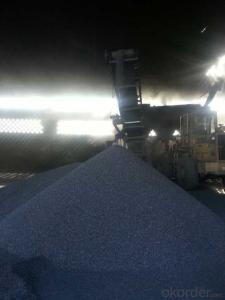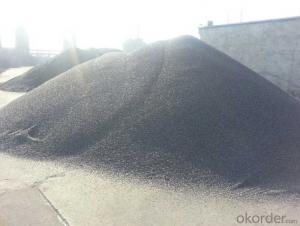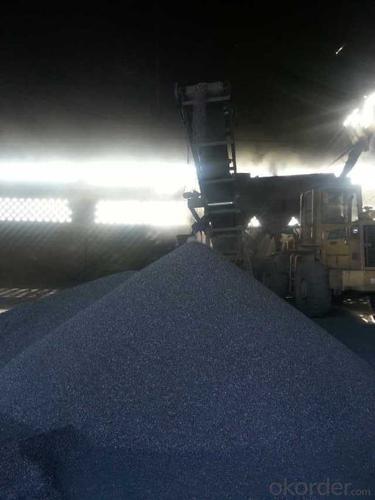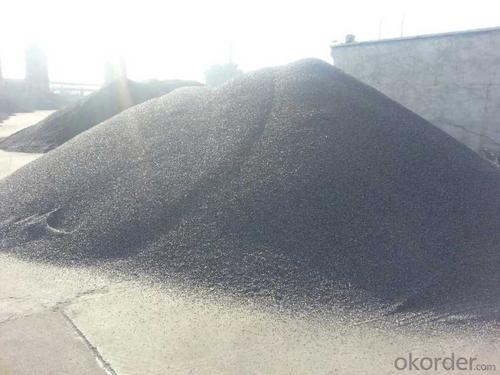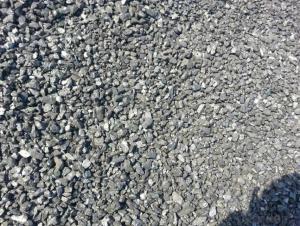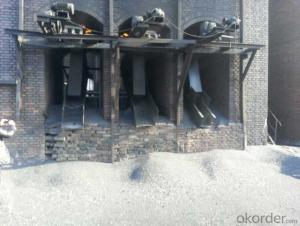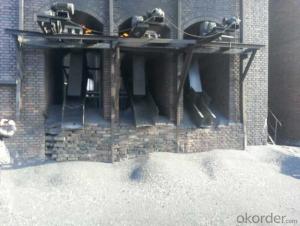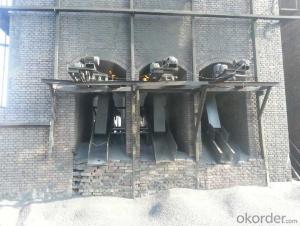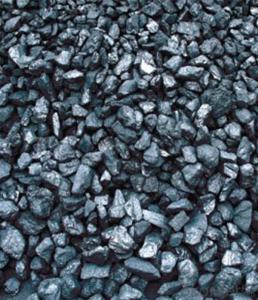Calcined Anthracite FC80-90 with stable quality
- Loading Port:
- Tianjin
- Payment Terms:
- TT OR LC
- Min Order Qty:
- 20 m.t.
- Supply Capability:
- 3000 m.t./month
OKorder Service Pledge
OKorder Financial Service
You Might Also Like
Packaging & Delivery
25kgs/50kgs/1ton per bag or as buyer's request
Specifications
Calcined Anthracite
Fixed carbon: 90%-95%
S: 0.5% max
Size: 0-3. 3-5.3-15 or as request
It used the high quality anthracite as raw materials through high temperature calcined at over 2000 by the DC electric calciner with results in eliminating the moisture and volatile matter from anthracite efficiently, improving the density and the electric conductivity and strengthening the mechanical strength and anti-oxidation. It has good characteristics with low ash, low resistvity, low sulphur, high carbon and high density. It is the best material for high quality carbon products.
Advantage and competitive of caclined anthracite:
1. strong supply capability
2. fast transportation
3. lower and reasonable price for your reference
4.low sulphur, low ash
5.fixed carbon:95% -90%
6..sulphur:lower than 0.3%
General Specification of Calcined Anthracite:
| FC | 80 | 83 | 85 | 88 | 90 |
| ASH | 16 | 14 | 13 | 10 | 8.5 |
| V.M. | 3 | 3 | 2 | 2 | 1.5 |
| S | 0.5 | 0.5 | 0.5 | 0.5 | 0.35 |
| MOISTURE | 2 | 2 | 1 | 1 | 0.5 |
Pictures
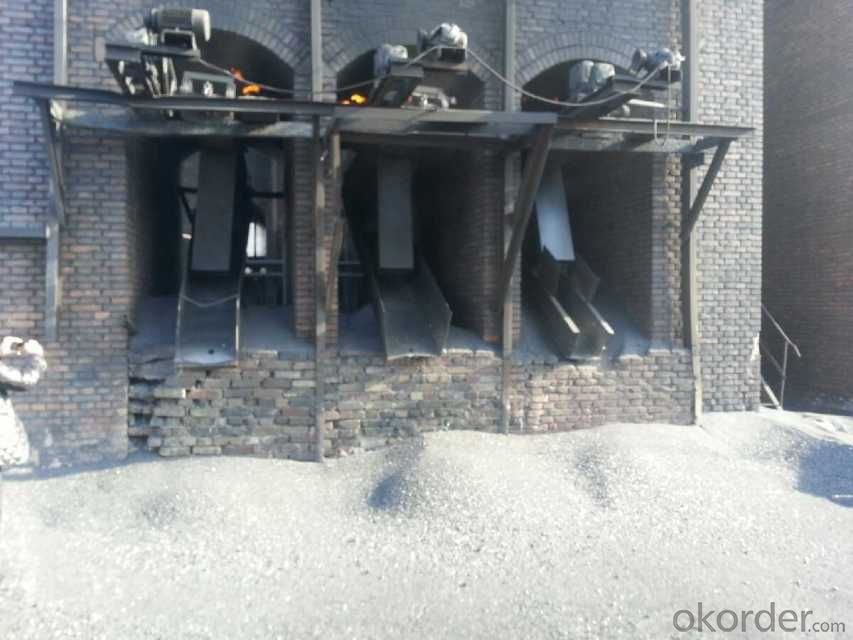
We are also strong at below materials, please contact us if you are interested in any of them:
Calcined Petroleum Coke
Carbon Electrode Paste
Carbon Electrode
- Q: How is carbon used in the production of carbon nanomaterials?
- Carbon is used as the raw material for the production of carbon nanomaterials. Different forms of carbon, such as graphite or carbon black, are transformed through various processes like chemical vapor deposition or arc discharge to create carbon nanotubes or graphene.
- Q: What is fullerene?
- Fullerene refers to a unique form of carbon molecule that is composed of interconnected carbon atoms forming a cage-like structure. It was first discovered in the 1980s and has since attracted significant scientific interest due to its distinct properties and potential applications in various fields such as electronics, medicine, and materials science.
- Q: Iron and steel are different in terms of carbon content
- . An iron carbon alloy with a carbon content of less than 2% is a steel, and a carbon content of more than 2% is called iron. Steel is widely used because of its toughness, elasticity and rigidity. Life is exposed to steel, but people call different. For stainless steel, whether or not the magnet is sucked on or not, as long as the quality standards are met, it is stainless steel. Therefore, from the perspective of metallurgy said, no rust said. The main element of stainless steel corrosion resistance is chromium. If the content of chromium is above 10.5%, the steel will not rust. When smelting, the alloy elements added are different, so there is a difference between the magnet and the suction.
- Q: What is carbon neutral manufacturing?
- Carbon neutral manufacturing refers to the practice of minimizing and offsetting greenhouse gas emissions produced during the manufacturing process. It involves implementing sustainable measures, using renewable energy sources, and investing in carbon offset projects to balance out the emissions released. This approach aims to achieve a net-zero carbon footprint, where the amount of carbon dioxide emitted is equal to the amount removed from the atmosphere, thus mitigating climate change impacts associated with manufacturing activities.
- Q: A carbon Roast Lamb Leg stores need to how much money
- You buy yourself a Roasted Whole Lamb furnace, generally in the 2600-3000 Roasted Whole Lamb Roast Lamb Leg can fix, baking method will provide. Can buy Roasted Whole Lamb furnace Ji'nan Thebaud Hardware Products Co. Ltd.
- Q: How does carbon impact ocean acidity?
- Carbon impacts ocean acidity through a process called ocean acidification. When carbon dioxide (CO2) from human activities is emitted into the atmosphere, a significant portion of it is absorbed by the ocean. Once in the ocean, CO2 reacts with water to form carbonic acid, which lowers the pH of seawater, making it more acidic. This increased acidity can have detrimental effects on marine life, particularly on shell-forming organisms like corals, mollusks, and some plankton, as it hampers their ability to build and maintain their calcium carbonate structures. Additionally, ocean acidification disrupts the delicate balance of marine ecosystems, affecting various species and ultimately impacting the entire food chain.
- Q: Carbon injection molding machine heating several degrees
- The physicochemical properties of PC plastics are as follows:One is amorphous plastic, Tg is 149~150 DEG C, Tf is 215~225 DEG C, molding temperature is 250~310 DEG C, and relative average molecular weight is 2~4.The thermal stability is better and increases with the increase of molecular weight.The rheological properties are close to Newton liquid, and the apparent viscosity is greatly affected by the temperature, which is less affected by the shear rate and increases with the relative average molecular weight. No obvious melting point, higher melt viscosity. PC molecule chain has benzene ring, so the rigidity of molecular chain is big.PC has good creep resistance and good dimensional stability, but it is difficult to eliminate internal stress.PC at high temperature, water easily degraded, molding requirements of moisture content below 0.02%.The product is easy to crack.Before molding, the PC resin must be fully dried. The fluidized bed drying method (drying temperature 120 to 130 DEG C, 1 ~ 2H), vacuum drying (110 degrees Celsius temperature, vacuum degree more than 96kPa, 10 ~ 25h), hot air circulation drying (above the temperature of 120 to 130 DEG C, 6h). In order to prevent the moisture absorption of the dry resin, it should be placed in the insulating box at 90 degrees. It should not be stored for a long time. When forming, the hopper must be closed, the hopper should be equipped with heating device, the temperature is not less than 100 degrees, and no heat insulation device hopper, a feeding amount is best less than half an hour of the amount of use, and should be stamped tightly.
- Q: What are the effects of carbon emissions on the stability of peatlands?
- Peatlands, composed of dead plants and mosses, are wetland ecosystems that act as important carbon sinks. However, the stability of these ecosystems is significantly impacted by carbon emissions, resulting in various environmental and ecological consequences. When carbon emissions, particularly from burning fossil fuels, are released into the atmosphere, they contribute to the overall increase in greenhouse gases like carbon dioxide (CO2) and methane (CH4). This increase in greenhouse gases leads to global warming and climate change, directly affecting peatlands. One primary consequence of carbon emissions on peatlands is the acceleration of peat decomposition. Global warming raises temperatures, increasing microbial activity in peatlands and speeding up the decomposition of organic matter. This process releases carbon dioxide and methane, further contributing to greenhouse gas emissions. It also causes peatlands to sink or subside, impacting their stability and contributing to land degradation. Furthermore, carbon emissions can change the hydrology of peatlands. Rising temperatures cause increased evaporation and reduced precipitation, resulting in drier conditions. This can cause the water tables to drop, inhibiting moss growth and the accumulation of new peat. As a result, peatlands become less effective at sequestering carbon and can even become sources of carbon emissions. The destabilization of peatlands due to carbon emissions has cascading effects on the entire ecosystem. Peatlands provide habitats for numerous unique and highly adapted plant and animal species. However, the drying and sinking of peatlands disrupt these ecosystems, leading to changes in species composition and distribution, as well as increased vulnerability to invasive species. Additionally, the release of carbon dioxide and methane from peatlands amplifies climate change. These greenhouse gases trap heat in the atmosphere, further warming the planet and exacerbating the cycle of peat decomposition and carbon emissions. In conclusion, carbon emissions have damaging effects on peatland stability, including accelerated peat decomposition, altered hydrology, and ecosystem disruption. These impacts hinder the ability of peatlands to sequester carbon and contribute to climate change, creating a negative feedback loop. It is essential to reduce carbon emissions and prioritize the preservation and restoration of peatlands to mitigate these effects and protect these valuable ecosystems.
- Q: What is carbon capture and storage?
- Carbon capture and storage (CCS) is a process that involves capturing carbon dioxide emissions from industrial sources, such as power plants, and storing them underground or using them for various purposes. It aims to mitigate the release of greenhouse gases into the atmosphere, helping to combat climate change by reducing carbon dioxide levels.
- Q: What are the effects of carbon emissions on the stability of grasslands?
- Carbon emissions have a significant impact on the stability of grasslands. One of the main effects is the alteration of the climate, specifically through the greenhouse effect. Carbon dioxide (CO2) is a major greenhouse gas, and the increased concentration of CO2 in the atmosphere leads to global warming. This rise in temperature affects grasslands by altering their natural growth patterns and disrupting the delicate balance of their ecosystems. Higher temperatures caused by carbon emissions can lead to increased evaporation rates, resulting in drier soil conditions. Grasslands are adapted to specific moisture levels, and any changes in these conditions can lead to reduced plant growth and increased susceptibility to drought. As a consequence, grasslands become less stable and more prone to desertification. Moreover, elevated levels of carbon dioxide can affect the nutritional quality of grasses. As CO2 concentrations increase, the relative proportion of essential nutrients in grasses may decrease. This phenomenon, known as nutrient dilution, can impact the health and productivity of herbivores that rely on these grasslands for sustenance. The decline in nutritional value can disrupt the delicate balance of predator-prey relationships and lead to a decline in biodiversity. Additionally, carbon emissions contribute to the acidification of soils. Increased carbon dioxide dissolves in rainwater, forming carbonic acid, which lowers the pH of the soil. Grasses are sensitive to changes in soil pH, and acidification can negatively affect their growth and nutrient uptake. Acidic soil conditions can also lead to the loss of important microorganisms that contribute to a healthy soil ecosystem, further destabilizing grasslands. Lastly, carbon emissions have indirect effects on grasslands through climate change-induced alterations in precipitation patterns. Changes in rainfall patterns can lead to shifts in plant composition and distribution, favoring invasive species or altering the competitive balance between different grass species. This can disrupt the stability and functioning of grassland ecosystems. In conclusion, carbon emissions have numerous detrimental effects on the stability of grasslands. These include changes in climate, increased vulnerability to drought, nutrient dilution, soil acidification, and alterations in precipitation patterns. It is crucial to reduce carbon emissions and mitigate the impacts of climate change to preserve the stability and integrity of grassland ecosystems.
Send your message to us
Calcined Anthracite FC80-90 with stable quality
- Loading Port:
- Tianjin
- Payment Terms:
- TT OR LC
- Min Order Qty:
- 20 m.t.
- Supply Capability:
- 3000 m.t./month
OKorder Service Pledge
OKorder Financial Service
Similar products
Hot products
Hot Searches
